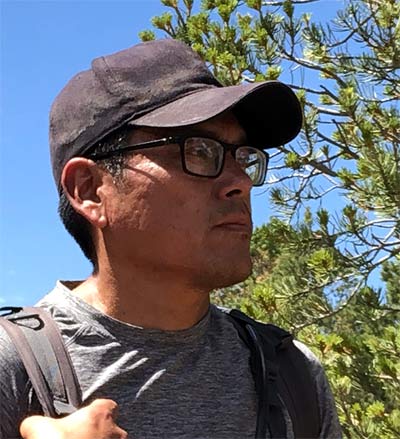
Chief nods to 2018 successes, says more needs to be done
WINDOW ROCK
After a year of successes, Navajo Nation Police Chief Phillip Francisco said there’s more work to do.
One of the biggest accomplishments for Francisco, who took the reigns in 2016, is the reestablishment of the Navajo Nation police academy, which began training its first police recruits in January.

Donovan Quintero
The Navajo Police Training Academy, which had closed in 2011, began this year with nine women and eight men. On June 25, Class 52 began a new chapter for the department when six men and six women were commissioned as Navajo Nation Police officers. Currently, 18 recruits are poised to become the second class to graduate from the tribe’s academy in March of 2019.
“The academy still going on. I think we have a good program,” Francisco said. “It’s an awesome place.”
Background checks are being done on 30 to 40 potential candidates. Those who pass will get a chance to become police recruits and, if they complete the 25-week academy, to graduate and become certified police officers.
By next year, Francisco anticipates all of the department’s 240 police officer positions will be filled. The chief said with that many it will mean one officer would provide service for 1,000 people.
“Even with 240 officers we’re still really understaffed, probably half the staff we really need to address crime,” he said. “We need, you know, over 400 to really be effective.”
Once the department fills all police officer positions, he said they will renegotiate their self-determination contract with the BIA for more funding in 2020. To do that, a nine-month study including number of calls, response time for service and manpower will begin in 2019 by an outside consultant. The data collected will be used in the request for additional money.
“The data will give us a little bit better idea on hard document that we can go and solicit for money and say, ‘Hey, this is what we did, we had professional contract come in, along with our assessments,’” Francisco said. “And say, ‘Here’s the numbers, here’s what we need. These are our shortfalls.
These are how we want to organize our department to be best use of what we have.
“‘But here’s what we need,’” he said. “‘And here’s our hard numbers.’ So that’s going to be coming.”
As more recruits graduate and are hired, the chief said the department’s $25 million annual budget would also pay for staff, such as dispatchers, and equipment. But with an anticipated 15 percent decrease in general funds expected in 2019, Francisco said the department will also reassess its manpower.
“We’re going to run out of funds from BIA, because once we fill a position, we’re kind of having a play by ear to see where we have to stop hiring,” he said. “For what the BIA gives us, we’re gonna have to look for other alternative funding.”
One of those alternative funding sources is the Indian Highway Safety grant, according to Division of Public Safety Director Jesse Delmar, worth over a half a million dollars. The grant could pay for up to 10 additional police officers.
The grant, funded by the BIA’s Office of Justice Services, is for catching drunk or impaired drivers, enforcing seatbelt laws, improving NPD’s traffic records system and for education to help reduce traffic related injuries and death.
Another alternative funding source is schools.
“We’re looking to negotiate contracts and build contracts with the schools so they can contribute money for officer salaries,” Francisco said, referring to School Resource Officers. “They’ll be basically working at the schools, we’ll be managing them, but they’re dedicated to the schools. That’ll give us the ability to hire more officers, because that’ll come back and supplement our funding.”
Other sources that could help pay officers’ salaries are communities that want police service in their area.
“Having those kind of relationships and working on those contracts will make it easier for those officers,” he said.
Saving money is also a future goal the chief said they have been working on.
“We’re looking to start our own fleet program, which will save us a significant amount of money rather than paying our Navajo Nation fleet a lot of money,” Francisco said. “(It) will save us quite a bit of money and put that back in operations.”
This year, NPD hired the first-ever public information officer, Christina Tsosie. They also hired the first-ever deputy chief, Darryl Noon, who served almost 23 years with the Farmington Police Department.
Francisco said Noon, a 1990 Shiprock High graduate, is expected to start in January pending his background check. Noon was selected from six applicants.
To further accountability and transparency, all Navajo Nation Police officers will be required to wear body cameras beginning in 2019. According to a November news release, the project took more than year with Class 52 being the first to use camera.
Starting Jan. 1, the chief said, the program will be “100 percent operational” in all of their districts.
“It will have a significant impact on citizen complaints, improve evidence gathering, and have a major impact for case prosecution,” the news release stated.
The public intoxication problem will continue into 2019. In 2017, police handled more than 16,000 calls across the reservation. While it is not a major crime, it takes most of an officer’s work shift.
And rather than taking a PI to jail, the chief said a detox center that provides counseling and treatment could serve as an alternative.
“Because after about eight hours, they’re right back out, still usually intoxicated,” he said. “We’re still picking people up and taking them in.”
Francisco said the department, along with the attorney general, Law & Order Committee, prosecutor’s office and Department of Corrections, are working on solutions to battle the PI problem.
Working in an old, dilapidated building, Francisco said he will request the new Navajo Nation Council and President-elect Jonathan Nez to fund the construction of two judicial centers in Window Rock and Shiprock – the department’s biggest districts.
“We don’t have the funding internally and we really need help from the delegates and the president’s office to help put that money in place because if not, we’re just gonna stay in the same building,” he said.
“They’re trying to build a $35 million judicial complex in Pinon, when there’s a small demographic there,” he said, “yet Window Rock and Shiprock are the biggest districts.
“This is a critical building,” he said. “We have corrections, we have all the headquarters for DPS, fire, criminal investigations, and EMS, everybody that’s in this area. We’re working out of this very old dilapidated building.”
Speaking of the new Council and president, Francisco said he looks forward to working with both branches.
“President-elect Jonathan Nez has been very supportive of us,” he said. “I’m very optimistic that his leadership will help us keep continuing what we are doing.”
With over half of the Council changing guard, the chief was not sure which delegate would hold which committee positions, but he is optimistic they will continue working together.
“A lot of times, you’re doing things, you don’t see the changes right away,” he said. “You’re doing a lot of work and you won’t see the changes for a year or two.
“Now, we’re getting to that point where you’ll start to see the differences in what we’ve done in the last two years,” Francisco said. “It’s going to be really exciting this coming year for the Navajo Police Department.”
To read the full article, pick up your copy of the Navajo Times at your nearest newsstand Thursday mornings!
Are you a digital subscriber? Read the most recent three weeks of stories by logging in to your online account.








 Highway 264,
Highway 264, I-40, WB @ Winslow
I-40, WB @ Winslow